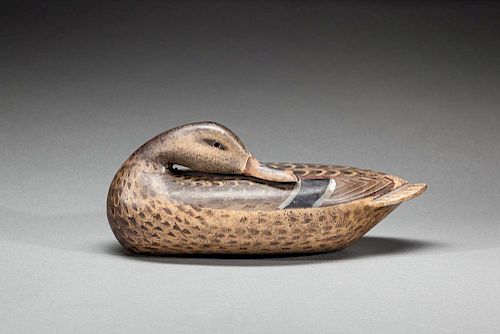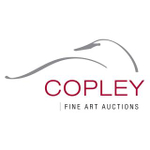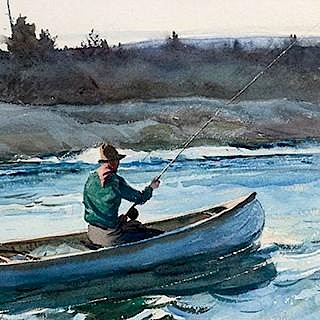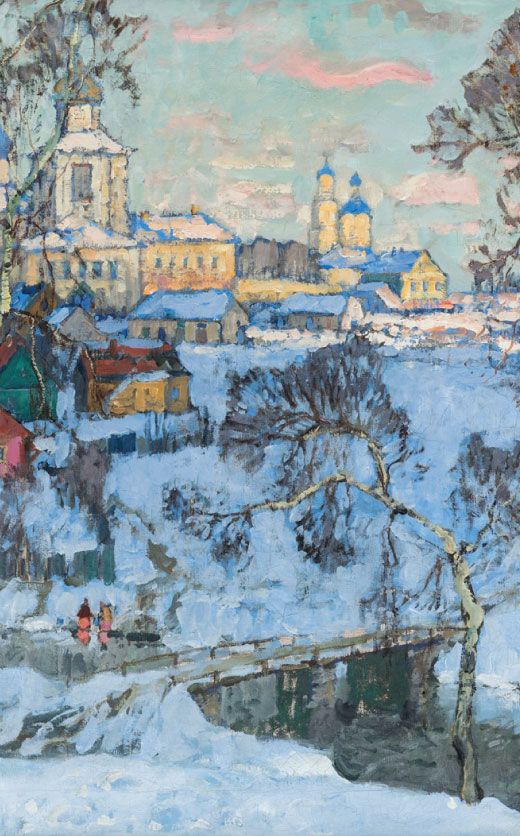Sleeping Mallard Hen
About Seller
20 Winter Street
Pembroke, MA 02359
United States
Founded in 2005, Copley Fine Art Auctions is a boutique auction house specializing in antique decoys and American, sporting, and wildlife paintings. Over the course of the last two decades, the firm has set auction records for not only individual decoy makers, but also entire carving regions. Copley...Read more
Two ways to bid:
- Leave a max absentee bid and the platform will bid on your behalf up to your maximum bid during the live auction.
- Bid live during the auction and your bids will be submitted real-time to the auctioneer.
Bid Increments
| Price | Bid Increment |
|---|---|
| $0 | $50 |
| $1,000 | $100 |
| $2,500 | $250 |
| $5,000 | $500 |
| $10,000 | $1,000 |
| $25,000 | $2,500 |
| $50,000 | $5,000 |
About Auction
Jul 25, 2015 - Jul 26, 2015
Copley Fine Art Auctions cinnie@copleyart.com
- Lot Description
Charles H. Perdew (1874-1963), Henry, IL, c. 1935
?Of his many styles, Perdew is most revered for his masterful sleepers and preening decoys. Both Robert Elliston and Charles Perdew felt that the presence of sleepers and preeners added a suggested calm to the rig that was more enticing to waterfowl. Whether this actually made any difference to the circling birds is subject to debate; however, the graceful pose inherent in these styles is desirable among collectors.? -Stephen O?Brien, Jr., ?Masterworks of the Illinois River?
An exceptional sleeping mallard hen with Charles Perdew?s best paint. Behind the neck is a small metal tube.
This decoy has all the traits one looks for in a premier Illinois River decoy, including elegant form, superb paint, fine craftsmanship, and excellent history having been gunned over by a founding member and past president of Ducks Unlimited, Louis H. Barkhausen.
In ?Perdew: An Illinois River Tradition,? author Ann Tandy Lacy discusses this rig: ?Further down the river, south of Peoria near Beardstown, one of Illinois? most highly respected conservationists also hunted over a rig of Perdew decoys. This hunter, Louis H. Barkhausen, was a co-founder in 1937 of Ducks Unlimited, an international organization for the preservation and reclamation of wetlands and waterfowl breeding grounds? Located on the back of each decoy, at the base of the neck, was a small metal tube that had been inserted to leave an opening from the hollow cavity in the body of the decoy to the outside air. This opening appears to be a breathing hole, the theory being that it would allow the decoy to ?breathe? and dry evenly on the inside and out. Supposedly this would decrease the chances of its cracking or splitting along the seams where the wood is joined. This breathing hole appears to be unique to the Barkhausen rig of Perdew decoys??
Provenance: Louis H. Barkhausen Rig
Private CollectionLiterature: Stephen B. O?Brien, Jr. and Julie Carlson, "Masterworks of the Illinois River," Boston, MA, 2005, p. 81, rigmate illustrated.
Frank Maresca and Roger Ricco, "American Vernacular," Boston, MA, 2002, p. 31, similar decoy illustrated.
Ann Tandy Lacy, "Perdew: An Illinois Tradition," Muncie, IN, 1993, pp. 96-97.Condition
In original paint with very light gunning wear, two very small old drops of paint on the left side, and right side of bill is reset.
- Shipping Info
-
Shipping info
Copley Fine Art Auctions does not handle the shipping of any items. Shipping is the sole responsibility of the buyer. Once your payment has cleared, and we have received your authorized shipping release form items may be released for shipment. Copley Fine Art Auctions, LLC shall have no liability for any loss or damage to such items. Buyers should allow up to four weeks for shipment.PLEASE BE AWARE THAT INTERNET BIDDERS MAY NOT PICK UP THEIR ITEMS AT THE SALE SITE. ITEMS CAN BE PICKED UP BY APPOINTMENT OR SHIPPED STARTING FIVE DAYS AFTER THE CONCLUSION OF THE SALE
-
- Buyer's Premium



 EUR
EUR CAD
CAD AUD
AUD GBP
GBP MXN
MXN HKD
HKD CNY
CNY MYR
MYR SEK
SEK SGD
SGD CHF
CHF THB
THB














